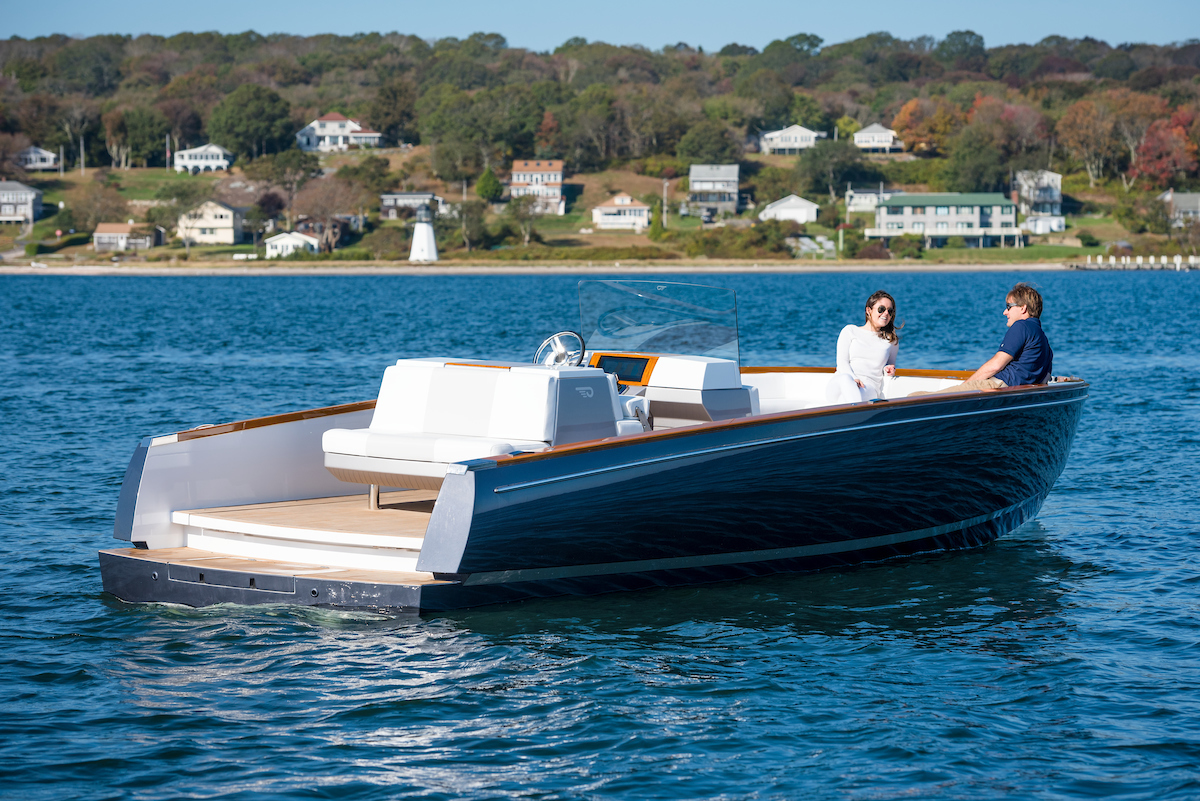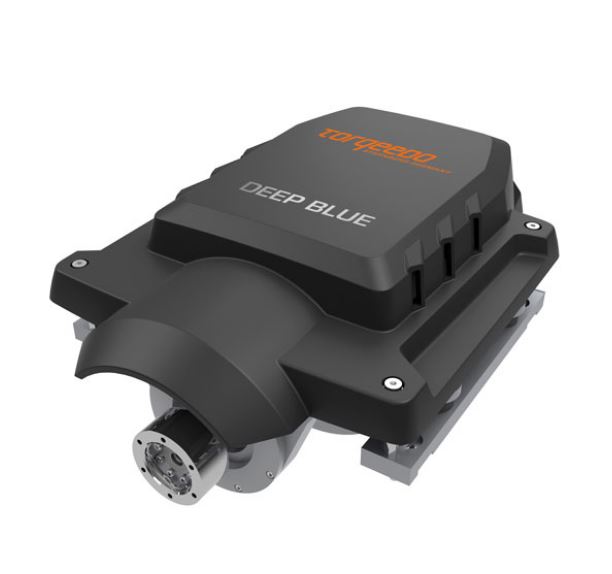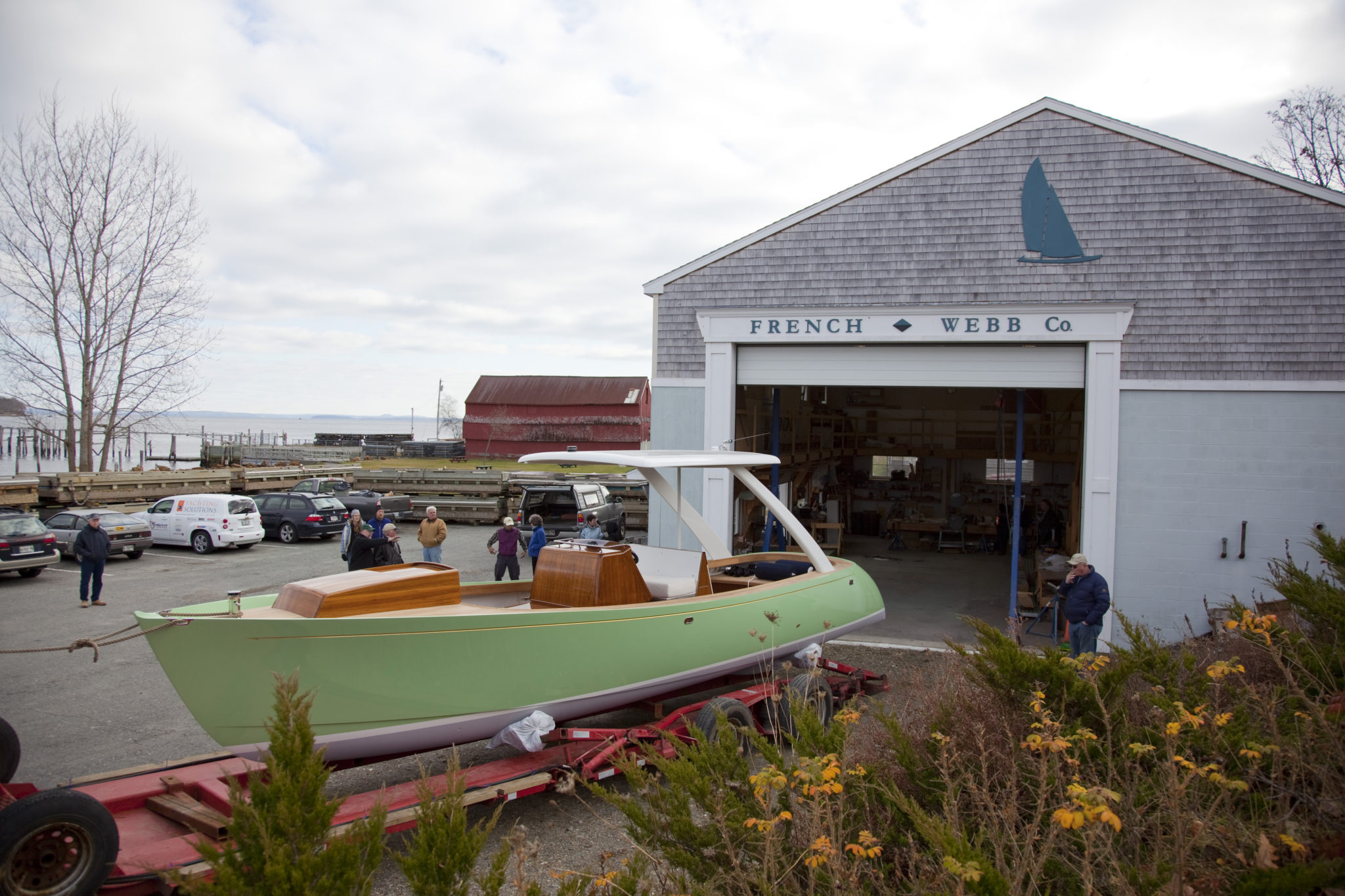Dasher: The Un-revolution in Electric Boats.
When it comes to boats, the revolutions seem to happen when they’re not that revolutionary. Take all-electric runabouts.

Our shop has spent nearly 10 years exploring electric propulsion in smaller craft. And earlier this year, the once impossible quietly happened: A major, high-quality American production boat builder began shipping an all-electric powerboat. Branded as the “world’s first all electric luxury yacht,” the svelte 28-foot Hinckley Dasher features twin 80hp inboard Torqeedo all-electric motors, BMW’s i3 waterproof lithium-ion batteries, and high capacity, dual 50-amp charging cables that can repower this boat in less than 4 hours. We’re sure that electrical pioneers, like Nikola Tesla, would take issue with Hinckley’s claim that Dasher is the “world’s first” all-electric yacht. Tesla showed working concept craft, not far from Hinckley’s designs, all the way back in 1898. And electric boats have come and gone since. Germany for example, developed an attack sub at the end of WWII that could manage 17 knots under all-electric power.
But Dasher certainly is the first mass produced, high-performance launch to go all-electric. That is the major news: Hinckley is betting its prized picnic boat and motor launch franchise on pure, nothing-but-electrons propulsion. Bravo!
What’s interesting — and confusing — is the reaction to Hinckley’s big wager on electricity. Take William Sisson’s solid review of Dasher from the marine industry publication, Soundings Trade Only. Sisson reports on the spiffy debut of Dasher at the Newport Boat show and the coverage of the boat from major brands like Fortune.com and Town & Country. Sisson digs into the carbon-epoxy construction, the cuddy-less cabin design, the lovely reverse sheered hull that was well drawn by Michael Peters. The review is worth a read.
But the rest of the narratives, that have defined the debate about electric drives, seem to be missing. All-electric propulsion imposes major limitations on a boat’s range and speed. Some of us happen to think that Dasher will suit a good number of boaters. Others don’t. And then there’s the story of how Dasher is driven by readily available motors and battery packs. And made from standard, if light, construction techniques.
With just a bit of designer-ish snooping we can get a solid feel for how exactly “un-revolutionary” Dasher truly is.

The Motors: Torqeedo’s 80i in-board motor has a list price of $23,999, times two, that’s around $47,998 for engines. That’s 50 percent more than purchasing an efficient 160hp marine diesel, or about 30 percent more expensive than twin 80hp IC motors. But keep in mind, marine diesels need fuel filters, exhaust and soundproofing. That costs money and nets out to about a 10 percent premium for an installed electric drive, over a traditional internal combustion engine. Outboard motors, on the other hand, yield about twice the power of these Torqeedos: A nice quiet gas outboard runs about $30,000 in first costs. But fuel efficiency is quite poor compared to the diesel; outboards are definitely the inexpensive solution. The 80i motor weighs in at 80kg, or about 176 pounds. Again times two, that’s 352 pounds. A comparable single diesel with a reverse gear runs about 900 pounds.
The Batteries: The BMW I3 batteries’ list price is $31,999, again times 2, yields about $64,000 total. The only comparable we can find is the fuel tank needed for an internal combustion engine. And that’s less than $1,000, installed. The i3 battery pack tips the scales at 256 kg or 563 pounds. And two systems for each motor come in at a beefy 1,126 lbs. Wow! Diesel fuel for the same range would be just 8 gallons, or 60 pounds. The energy density of fossil fuels is what makes it impossible to beat. This 1,200 lbs in batteries is why Hinckley had to work hard in construction measures to save weight. It’s the only way the builder could add the batteries for the modest range they needed.
Remembering Zogo.
 Another way to compare Dasher is take a look to our 29’ hybrid launch Zogo, designed in 2008. Here we installed a 110hp diesel with a 7kw hybrid electric system that weighed about 900 lb, plus a 30-gallon fuel tank that weighed about 270 lbs, full. That yielded a range of about 90 miles at wide-open-throttle of 17 knots, or 20 mph. And a lithium-ion battery bank of 14kwh, at about 400 lb. The total weight of the drive-train and fuel was 1,570 lb, times 1.2 to account for the soundproofing, fuel filters, and other gear necessary for an internal combustion engine installation. In all, that’s 1,900 lb in total weight, compared to Dasher’s 1,478 lb for more motors and power.
Another way to compare Dasher is take a look to our 29’ hybrid launch Zogo, designed in 2008. Here we installed a 110hp diesel with a 7kw hybrid electric system that weighed about 900 lb, plus a 30-gallon fuel tank that weighed about 270 lbs, full. That yielded a range of about 90 miles at wide-open-throttle of 17 knots, or 20 mph. And a lithium-ion battery bank of 14kwh, at about 400 lb. The total weight of the drive-train and fuel was 1,570 lb, times 1.2 to account for the soundproofing, fuel filters, and other gear necessary for an internal combustion engine installation. In all, that’s 1,900 lb in total weight, compared to Dasher’s 1,478 lb for more motors and power.
The comparative numbers tell an interesting story:
- Dasher: 6,500 lb displacement — 1,500 lb = 5,000 lb of structure and stuff.
- Zogo: 5,500 lb displacement – 1,900 lb = 3,600 lb of structure and stuff.
For the record, Zogo’s top speed with 7kw, or 10hp, of electric power is 7 knots or 8 mph. Cruise speed under electric is 4.5 – 5 knots or 6 mph. And range under electric is about 25 miles at cruise speed. Zogo’s top speed in diesel mode with 110 hp, is 17 knots; cruise speed is 12 knots and a range of about 180 miles.
All that leads to a big question: Why is Dasher, a highly touted, no solid wood, all carbon constructed boat, essentially 1,500 pounds heavier than a composite launch we designed a decade ago? Good question.
One Small — But Electric — Step
 Hinckley has done an excellent job of presenting a wholesome and conservative electric power option ideal for its customers. Dasher is not groundbreaking. She’s made of tested technology and built to modern, sensible specs. And that’s a really good thing! A large builder had enough confidence in the technology to offer and service a true all-electric boat. That’s something that our industry has been scared of for far too long.
Hinckley has done an excellent job of presenting a wholesome and conservative electric power option ideal for its customers. Dasher is not groundbreaking. She’s made of tested technology and built to modern, sensible specs. And that’s a really good thing! A large builder had enough confidence in the technology to offer and service a true all-electric boat. That’s something that our industry has been scared of for far too long.
Our two cents? Hinckley missed the most compelling reason to own a Dasher. You will never, ever have to go to a fuel dock again. Plug her in when you tie up at your home dock, give yourself a few hours, an she’ll always fueled and ready to go.
In our business, that’s shocking value.